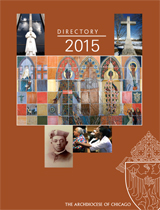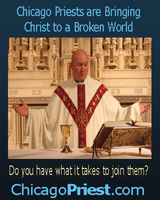October 26, 2008
Vatican photographer remembers popeDuring a visit to Chicago, Arturo Mari shares insight into legacy of John Paul II
After having spent 51 years photographing six popes, Arturo Mari hung up his cameras last year, retiring as the Vatican’s official photographer.
Mari, 68, the main photographer for L’Osservatore Romano, the Vatican newspaper, began his career at age 16, working for an agency on an assignment to photograph Pope Pius XII wearing a crown and being carried on a gestatorial chair at a beatification ceremony.
He documented Pope John XXIII announcing his plans to convoke the Second Vatican Council. And he was in St. Peter’s Square in 1981 to capture the image of Pope John Paul II lying in his secretary’s arms after being shot.
He recently visited Chicago on the anniversary of Pope John Paul II’s election to the papacy and spoke to staff writer Alicja Pozywio. Some of his many photos are featured on the next page.
Catholic New World: It is said about you that while accompanying the pope you were somehow inconspicuous. You were present and available anytime but you did not draw attention to yourself.
Arturo Mari: The point was to act with prudence and with the greatest possible respect. It never could have been possible, had I been on the same level with the pope. I was always just behind him. I did not even want to collide with other reporters that were near the Holy Father. It was again my effort to respect other reporters and their work. As long it was possible, I always wanted to follow these rules.
CNW: Some of his pilgrimages, such as the historical one to Guatemala during which the crowds had to be silenced, were quite a challenge. Then, the words were said: “Quiet, the pope is speaking.” How did the Holy Father surmount these challenges?
Mari: When one talks about Guatemala, one has to remember, that the people there are very unfortunate and live in great misery. Really, I remember shouts almost deafening the words of the Holy Father.
As an eyewitness of that event, I can testify that there were antipapal slogans coming from the first rows that, as it turned out, were organized by the governing regime. People who were further down wanted to listen to the pope, but because of a great noise they could not.
At that time, the pope was moved deeply, stood up, raised his crosier and said, that only with this sign is victory possible.
CNW: Was that the end of provocations?
Mari: No, there is another sad event associated with this one. Propaganda of the regime in power had proclaimed that the pope did not want to greet the pilgrim women gathered on the presidential palace square. However, when the pope was walking into the palace, on the one side there were people standing organized by the government and on the other side there was a group of people shouting, “We want peace”
In that last group there were older women with pictures hanging from their necks. Noticing this, I directed the pope to that group. Then the pope stopped there, greeted them and touched their faces.
The next day’s newspapers announced that the pope passed by widows standing there; not even acknowledging their presence. The government had wanted to discredit the pope, but because I took the pictures of the whole event, they achieved exactly the opposite. The pictures were published, which made the government obsessively mad to the point of threatening my life.
For my own records, I had sent those pictures to Reuters and the Associated Press and instantly the whole world saw the truth.
CNW: There is a Polish saying that the eyes are the windows to man’s soul. In many pictures of yours, the pope’s eyes are extremely expressive. What did you see in them?
Mari: When I speak with people, I always try to look them straight in the eyes. Similarly, when I take pictures, the eyes are very important to me, and I know that they can say a lot about a person. Therefore, when I took pictures of the Holy Father, I always wanted to catch his glance, the expression of his eyes. So, I ask you what you could see in the pope’s eyes on the pictures I took.
CNW: I saw a man gazing into reality in the deepest sense. Since we talk about the eloquence of the pope’s body language, it follows that we learned a lot just from looking at him. You were photographing it. Were you aware of being part in the creation of this extraordinary legacy?
Mari: As I said earlier, the Holy Father was an extraordinary person. His very presence was always a shining example. Through his example, he taught how one can establish communion with people everywhere.
Regardless of whom he met, whether professors, theologians or common people, the pope treated people with respect and love. He showed in his behavior that he was totally devoted and at the disposal of the other. On my behalf, I was doing nothing else but making his legacy visible and concrete. I am happy I was part of that legacy.
CNW: You’ve said that the most moving picture you took of the pope is the one with the cross, taken on Good Friday before his death. Why do you think so?
Mari: This picture presents to me a summary of John Paul’s II pontificate. I recorded it at the moment, the Holy Father supports his face on the cross and presses it to his heart. It shows the great suffering and the total surrender to the mother of God, enclosed in his pontifical motto Totus Tuus, and the reflection of his whole life of service to the brethren. This expresses the mystery of the cross.
CNW: Photographing the pope and on his pilgrimages you were at work. Did you manage to take part in the spiritual journey while taking pictures?
Mari: Being half a meter behind the pope, I saw what he saw and I heard what he heard. It was unavoidable not to experience what was happening on the pilgrimage and it helped my work because somehow I identified with the pope himself.
CNW: Do you still feel John Paul’s presence?
Mari: Yes. For me nothing really has changed. Every time I talk about him or share my experiences, I feel his presence.
Catholic News Service contributed to this story.
 Catholic
New World - Newspaper for the Archdiocese of Chicago
Catholic
New World - Newspaper for the Archdiocese of Chicago Archdiocese of Chicago Directory
Archdiocese of Chicago Directory Oficjalne wydawnictwo Archidiecezji Chicago w języku polskim
Oficjalne wydawnictwo Archidiecezji Chicago w języku polskim